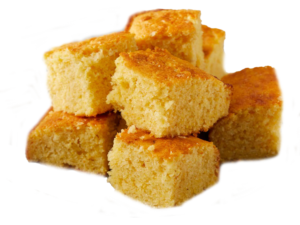Cornbread History
 Native people in the Americas began using corn (maize) and ground corn as food thousands of years before Europeans arrived in the New World. First domesticated in Mexico around six thousand years ago, corn was introduced to what is now the United States between three thousand and one thousand years ago. Native cooks developed a number of recipes based on corn, including cornbread, that were later adopted by European settlers and enslaved African people—especially those who lived in Southern colonies.
Native people in the Americas began using corn (maize) and ground corn as food thousands of years before Europeans arrived in the New World. First domesticated in Mexico around six thousand years ago, corn was introduced to what is now the United States between three thousand and one thousand years ago. Native cooks developed a number of recipes based on corn, including cornbread, that were later adopted by European settlers and enslaved African people—especially those who lived in Southern colonies.
Aside from eating corn on the cob, Native people also mixed corn kernels with lye to produce hominy through an ancient process called nixtamalization. Both hominy and unprocessed corn were then ground up to varying degrees to make dishes like sofkee (a corn-based soup or drink) and grits or to make corn flour. Frequently, corn flour was, and continues to be, used to make various cornbread dishes, like corn or ash pone, tamales, arepas, and tortillas. In contrast, cornmeal tends to be coarser than corn flour and is produced by grinding dry, raw corn grains. Besides cornbread, Native people also used cornmeal and hominy to make grits and alcoholic beverages, such as the Andean chicha.
Although Native people in the Americas first cultivated corn, it was introduced in West Africa by European traders shortly after contact through the Atlantic slave trade, and quickly became a major staple in African cooking. Cornbread dishes in Senegambia and the Sahel represent the transference of cuisine and culture that occurred across the Atlantic Ocean. Cornbread has become a “cornerstone” of cuisine within the southeastern United States as well as being featured on the plates of African Americans, European Americans, and Native people alike.
Cited from here.
